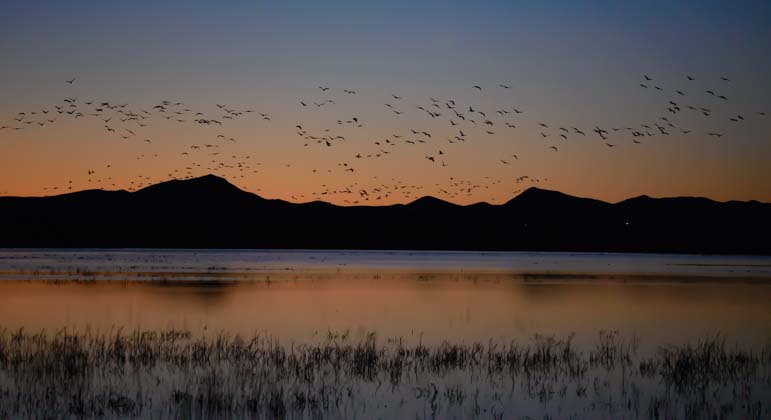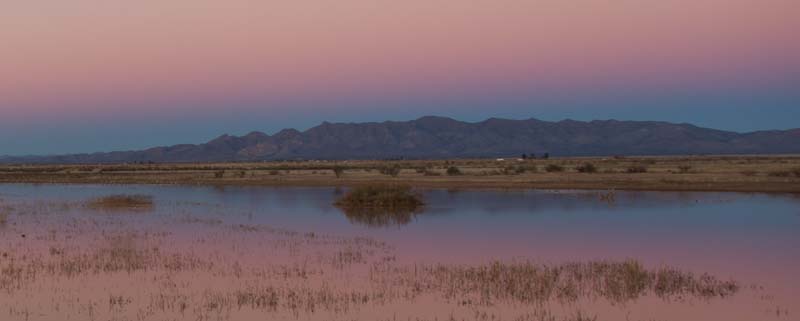February, 2015 – Every winter an amazing sandhill crane extravaganza takes place in southern Arizona and New Mexico. These big, raucous birds don’t mean to put themselves on display, but whenever 20,000 or so of any species show up in one place, whether its to witness a rock concert or just to loll about by the water’s edge, the sheer volume of identical creatures becomes an Event.
The sandhill cranes show up in November every year, and they hang around until March, and one of the best places to see them during those months is around Willcox, Arizona. When we woke up on our first morning there, it was the cries of sandhill cranes flying overhead that got us out of bed.
“It’s them!” I said to Mark excitedly as I whipped off the covers and flew out the door in my PJ’s. “They’re here!”

We look up and see wild zig-zag patterns of sandhill cranes in the sky.
“Huh?” He said, clambering out of bed behind me. “Who?”
“The birds!” I said with a grin. He quickly joined me outside the rig in the pre-dawn light, and we both stared at the sky in awe as hundreds of sandhill cranes flew right over our trailer, making scattered V-formations all across the sky.
This was their morning commute, and they were honking and jostling around in the sky just like motorists do on the freeways every morning on their way to the office. These guys were heading for their favorite foraging grounds, however. Once there, they would catch a bit of breakfast and then find a quiet spot for some mid-day frolicking or perhaps a nap. In the late afternoon they’d grab another quick bite to eat and then commute home to roost.

These guys are heading to breakfast out in the farm fields.
One of the best viewing areas is the roosting area at Whitewater Draw, a wide and shallow body of water about 6 miles south of the tiny town of Elfrida. As we drove down there in the middle of the day, we saw little pockets of sandhill cranes flying here and there, and we spotted little groups of them standing around in the farm fields. Their distinctive cries filled the air now and then as they called out to each other.
Great exhibitions often come with entertaining sideshows, and the sandhill crane exhibition at Whitewater Draw is no exception. A pair of great horned owls had taken up residence in a large lean-to building, living in the rafters and watching all the crazy bird people coming and going below them.

The “sideshow” at the sandhill crane extravaganza
Crazy bird people never miss a bird trick, though, and these birders had set up a row of seats right below the owls so everyone could have a good look at them. When we got there, only one owl was in the rafters, but he made some priceless faces for us as we set up our tripods and took portrait shots of him.

Throngs of birds line the shore
A little ways from this shelter is a paved walking path for people to stroll along the edges of the water and take in the exotic spectacle of thousands of large birds standing around. At midday, most of the flock was out in the farm fields, but a sizable number was still at the water’s edge here at Roost Central.

These guys were busy and oblivious to the people watching them from the walking paths nearby!
The noise of these guys conversing among themselves was a low, continuous hum.

Every so often a pair or trio would fly by.
Overhead we’d catch them flying by every so often. This was a lazy time of day for them, and they flew past in pairs and threes. Most of their social activities were taking place on the ground, though, and they strutted and flapped and preened and marched around on the far side of the pond. Every once in a while the noise of their cries would rise momentarily and a few birds would take to the air and fly to a new spot.



Hey! Wait for me!!!
As the sun began to set, we suddenly began to notice small flocks of cranes flying in. The din of squawking and flapping from the birds on the ground would swell slightly when a new flock was sighted in the distance.

As the sun began to sink in the sky, small flocks appeared on the horizon.
As the flock would get closer the cries from the crowd on the ground would increase. Then another flock would show up on the horizon and the squawks from the home team would grow a little louder.

More and more flocks began arriving.
Soon the arriving flocks were truly enormous. Literally thousands of birds were arriving at once, coming in from all directions and flying in massive V’s and W’s. The welcoming song from the birds on the ground grew ever louder, as if an orchestra conductor were leading them, waving his baton and flapping his arms and coaxing them to sing ever louder.

The noise of the excited birds on the ground and in the air calling to each other was deafening!!
The crescendo grew louder and louder until the sound was truly startling. It was as if the rock stars had arrived. The crowd on the ground surged as the arriving birds landed, and the noise of them all squawking at the tops of their lungs became a defeaning din.
For once, the people — the humans watcing all this — were all silent. Crazy birders, maniac photographers, and happy couples out for a stroll, all stared in stunned silence as the Arrival of the Cranes took place.

People watch the cranes arrive.
We all watched with silly, happy smiles too. For once, humanity was completely upstaged by Nature as this miraculous event unfolded before us, totally beyond our control.
And then, as if a light switch had been thrown, the vivid orange of sunset was gone, and delicious shades of pink and blue slowly blanketed the sky. The birds had all landed now, and the roar of excitement was gone from the air.

Peace reins once the birds have all found a spot by the water’s edge.
The birds didn’t completely settle down for hours, though, and we heard them long into the night. Little squabbles would break out now and then, and suddenly a bird or two would take to the air in a huff, squawking loudly as he flew.
First thing in the morning, about an hour before dawn, we crept down to the water’s edge, drawn by the rising sound of the sandhill cranes. When it was finally light enough to see across the pond, we noticed that the cranes had settled in the water overnight rather than on shore. No dry toes at bedtime for these guys. They like to stand knee deep in water when they sleep!

We creep down before sunrise and find the birds slept standing in the water overnight!
They shuffled around and, one by one, each bird’s head came out from under its wing as it shook the fuzzies and sleepies from its feathers. And then the low hum of crane squawks began to grow again. Soon the low rumble became a roar, rolling across the water like thunder, and then suddenly the pitch seemed to rise and the noise peaked, just as it had the night before.
The rock stars had taken flight, and they were off — and they were ushered off stage with a cacophony of beating wings and loud squawks. Thin ribbons of birds began to fill the sky, and they wove their jagged patterns from horizon to horizon as they set off to get breakfast.
In no time, the number of birds in the water had dwindled to just a small remaining few. The morning show was over, and the rush hour commute to the distant farm fields was well underway.

The raucous send-off is just as loud and wild as the welcome home was the night befor
Our most recent posts:
- How to Install Starlink Gen 3 in an RV? Use the Speedmount! 08/07/25
- Escape to Paradise – Rocky Mountain Magic! 08/01/25
- Is Forest River a Good RV? Well Built? Here’s Our Experience 06/20/25
- Sunset Crater Nat’l Monument – Lava & Camels at Bonito CG! 06/06/25
Subscribe
Never miss a post — it’s free!
More Info about the Sandhill Cranes of Arizona:
- Sandhill cranes at Whitewater Draw – AZ Game and Fish
- Sandhill Cranes Info – Wildbirds Online
- Wings Over Willcox – Annual Sandhill Crane Festival in Willcox AZ
Related posts about special animal encounters:
- Baby Sandhill Cranes Hatching in Sarasota Florida
- Monarch Butterfly Migration in Morelia Mexico
- Burrowing Owls near Phoenix Arizona
- Wild Birds (** Wild Parrots **) in Huatulco Mexico (halfway down the page)
<-Previous || Next->
New to this site? Visit our Home page to read more about our full-time traveling lifestyle and our Intro for RVers to find out where we keep all the good stuff. If you like what you see, we'd love for you to subscribe to receive our latest posts!

Emily, an amazing incite and photographs into the lives of the Sandhill Cranes. After reading your wonderful post I had to look a bit more at large formations of birds as I always wondered why they fly in formation and who leads? I found that the “v” formation is more energy efficient, they take it in turns at leading and they also all time the flapping of wings which saves energy. Amazing how they work together. (the full articles of why is here … http://www.dailymail.co.uk/sciencetech/article-2938280/Taking-turns-driving-seat-Migrating-birds-alternate-leads-tiring-v-formation-save-energy.html)
It’s neat that the scientists have finally proved what cyclists and other vehicle racers have known for ages — it’s a whole lot easier if you’re drafting behind someone and have a wind block!! In cycling they call the diagonal formation an “echelon.” Funny thing — years ago I read that scientists thought the birds in the back squawked to tell the guy at the front to fly faster. But with cyclists, all the chit-chat is just socializing and sometimes a bit of griping that the guy in front is going too fast. Maybe someday the scientists will prove the birds do that too!!
reminds me of one of my favorite books – A Sand County Almanac, by Aldo Leopold. Thanks for the pictures!
What a delightful sounding book, Liz. Thanks for the tip!! Reading the description of it reminds me of one of my all time favorites, “The Outermost House” by Henry Beston!!!!
Two other great places to see sandhill cranes this time of the year are Bosque del Apache National Wildlife Refuge near Socorro, NM, and Aransas National Wildlife Refuge north of Padre Island National Seashore in Texas. And at Aransas you even see some of the few remaining, even larger whooping cranes. The young whooping cranes look very much like sandhills, but turn white as they mature. Both refuges also have large flocks of snow geese and many other waterfowl during winter. And both are popular with those other birds that fly south for the winter–snowbirds with very long telephoto lenses!
We knew about Bosque del Apache but were unaware they go to Padre Island too. Thanks for the tip! The snow geese would be wonderful to see…
Aransas National Wildlife Refuge is nearest the town of Rockport, TX. We found the best place to photograph whooping cranes was in the small community located just outside the gate of Goose Island State Park. The farmers and homeowners there lure them away from the refuge and across St. Charles Bay with deer feeders that drop corn at regular intervals. After you have been that close to the “whoopers”, you understand the name–just as you found out when the sandhills took off and landed at Wilcox.